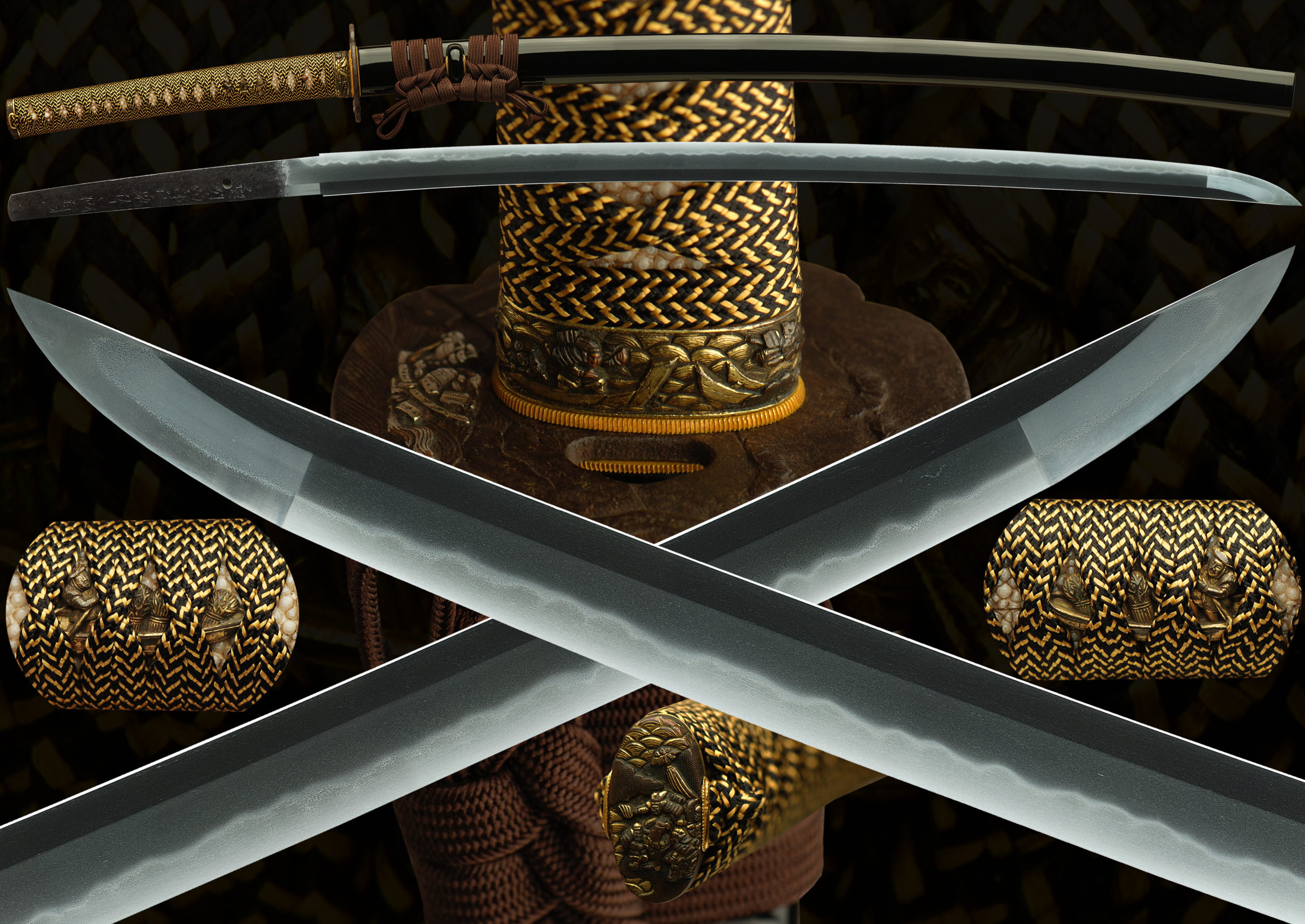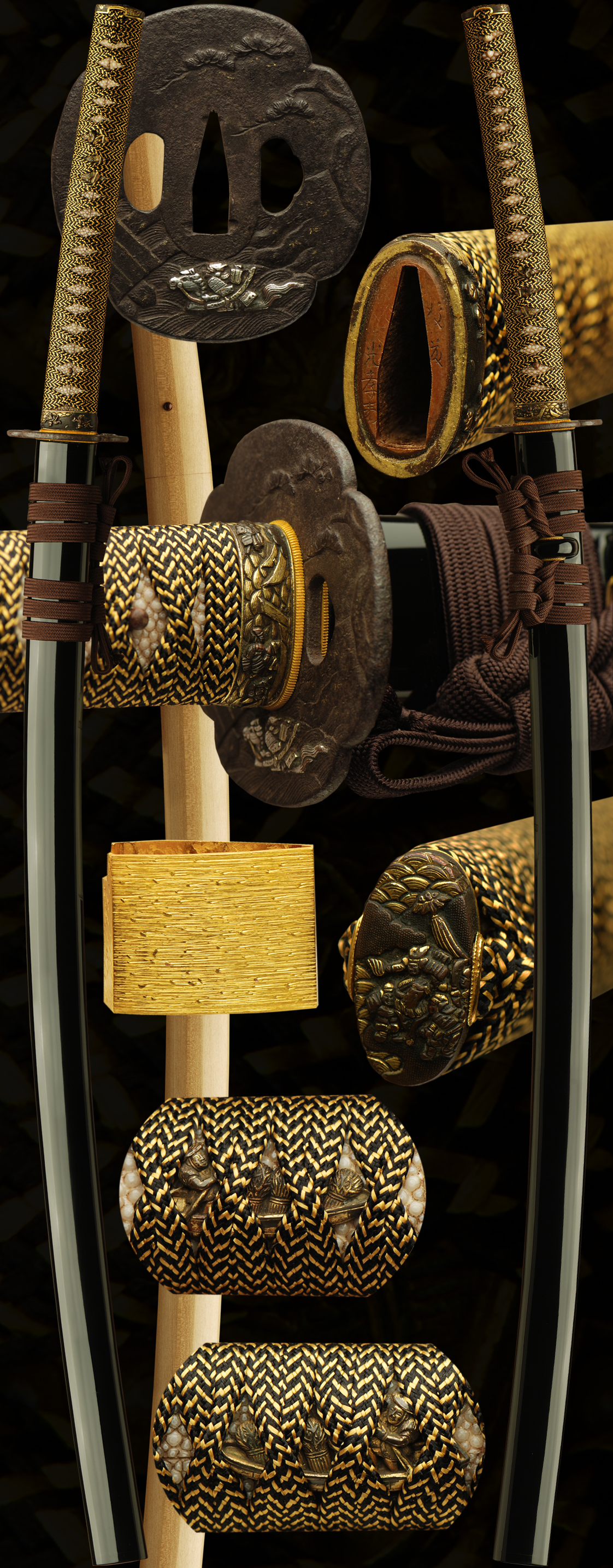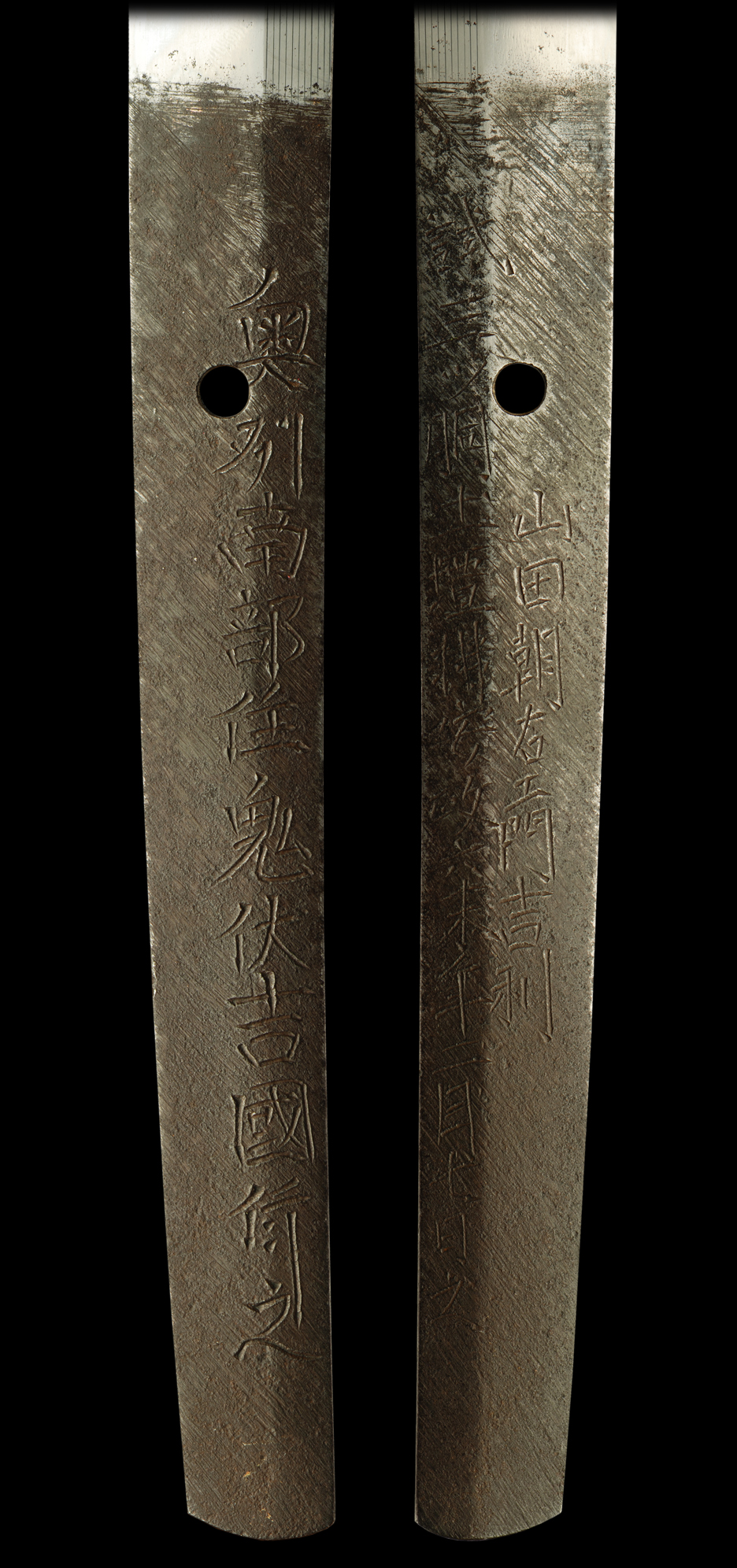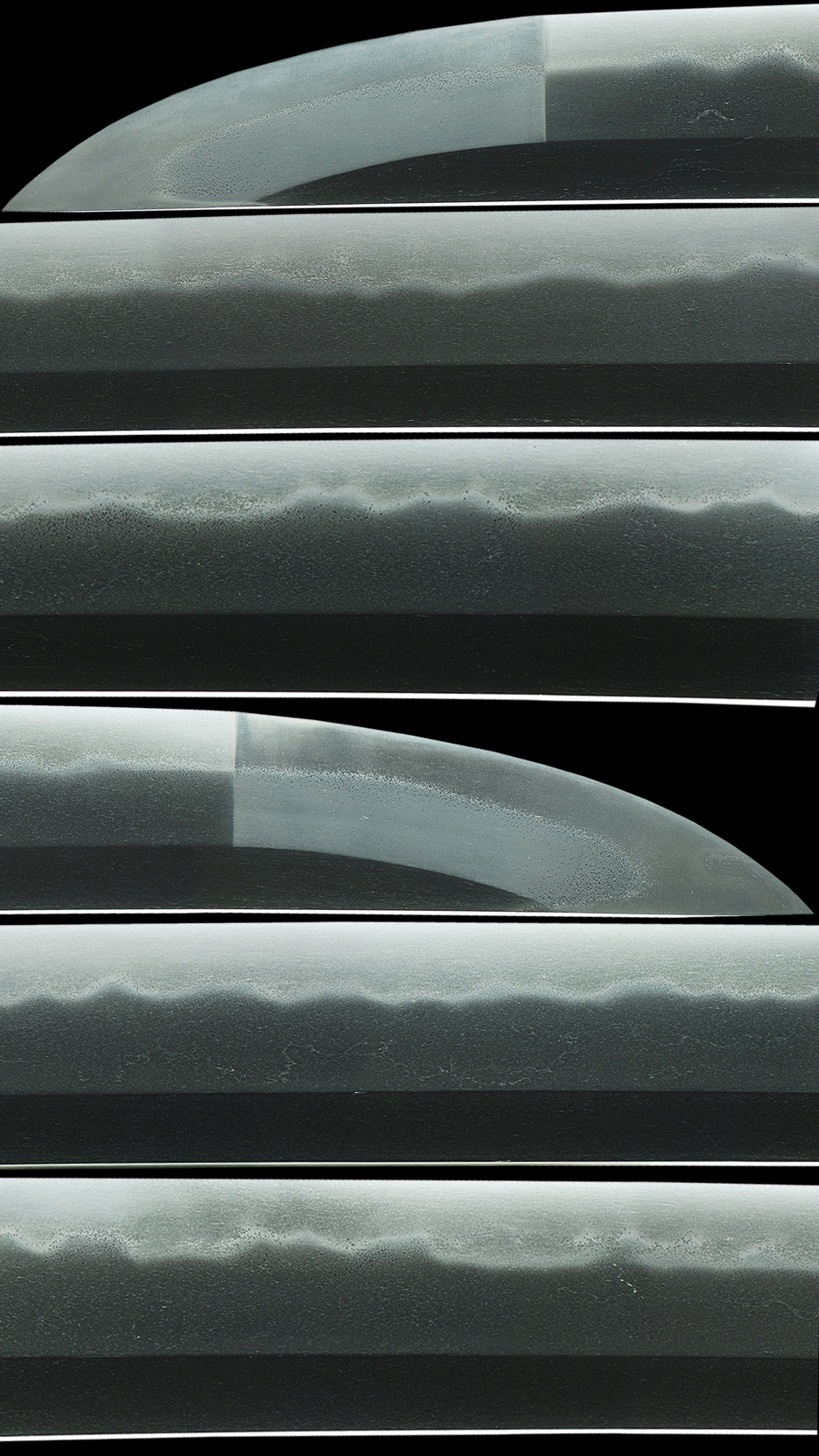A beautifully mounted sword in the Bizen tradition fully signed with cutting test attribution that this sword cut through 3 bodies by the famous Yamada family sword cutter YAMADA ASA’EMON YOSHITOSHI
An outstanding katana which is signed of the Shinshinto period. This sword reminds one of older Bizen work. This blade has a long Kissaki and attractive Sori and the hamon is frosted in nie. The activities in Ha are very beautiful with an abundance of ji-nie, the hamon appears very strong and rich looking. It is an attractive gunome midare. There is ashi and yo to be found. The hada is covered in ji-nie and is a mokume itame mix.
Ubu with one hole, this katana is from the Shinshinto era and boasts of classical work . The hada has a dense itame with mokume with a whitish jigane. Ko-nie layers the entire hamon blanketing the nioi-guchi.
The Koshirae is stunning with a matching Musha (samurai in battle) motif finished in shakudo and gold. The saya is a black lacquer and black and gold ito and brown sageo to finish. The habaki is gold washed. The fuchi is signed.
The sword is 27+” and is signed from the Edo period mounted in shirasaya and with koshirae. A great package papered and polished and ready for the collector. THIS SWORD COMES IN SHIRASAYA AND HAS A TSUNAGI FOR THE MOUNTS.
The sword is signed:
mei omote:
Ôshû Nanbu-jû Onibushi Yoshikuni kore o saku (奥州南部住鬼伏吉國作之) – “made by Onibushi Yoshikuni, resident of Nanbu in Mutsu province”
mei ura:
Yamada Asa’emon Yoshitoshi (山田朝右衛門吉利) Mitsu-dô dotanbarai Ansei roku hitsujidoshi nigatsu nanoka kore o tamesu (試三ッ胴土壇拂安政六未年二月七日之) – “Yamada Asaemon Yoshitoshi Tested on the seventh day of the second month of Ansei six (1859), year of the sheep, by cutting through three bodies and into the earthen mound beneath.”
- Signature:
mei omote:Ôshû Nanbu-jû Onibushi Yoshikuni kore o saku (奥州南部住鬼伏吉國作之) – “made by Onibushi Yoshikuni, resident of Nanbu in Mutsu province”mei ura:
Yamada Asa’emon Yoshitoshi (山田朝右衛門吉利) Mitsu-dô dotanbarai Ansei roku hitsujidoshi nigatsu nanoka kore o tamesu (試三ッ胴土壇拂安政六未年二月七日之) – “Yamada Asaemon Yoshitoshi Tested on the seventh day of the second month of Ansei six (1859), year of the sheep, by cutting through three bodies and into the earthen mound beneath.” - Nagasa: 27-1/8 inches
- Sori: 13.5 mm
- Width at the ha-machi: 33.3 mm
- Width at the yokote: 25.3 mm
- Thickness at the mune-machi: 7.9mm
- Construction: Shinogi zukuri
- Mune: Iori
- Nakago: Ubu
- Kitae: Itame/mokume
- Hamon: Midare Gunome
- Boshi: Maru
- Condition: New Sashikomi polish
(shipping and insurance included)
Email us if your interested in this item and remember to include the order number for this item: fss-773.
Click to Enlarge Image
Click to Enlarge Image
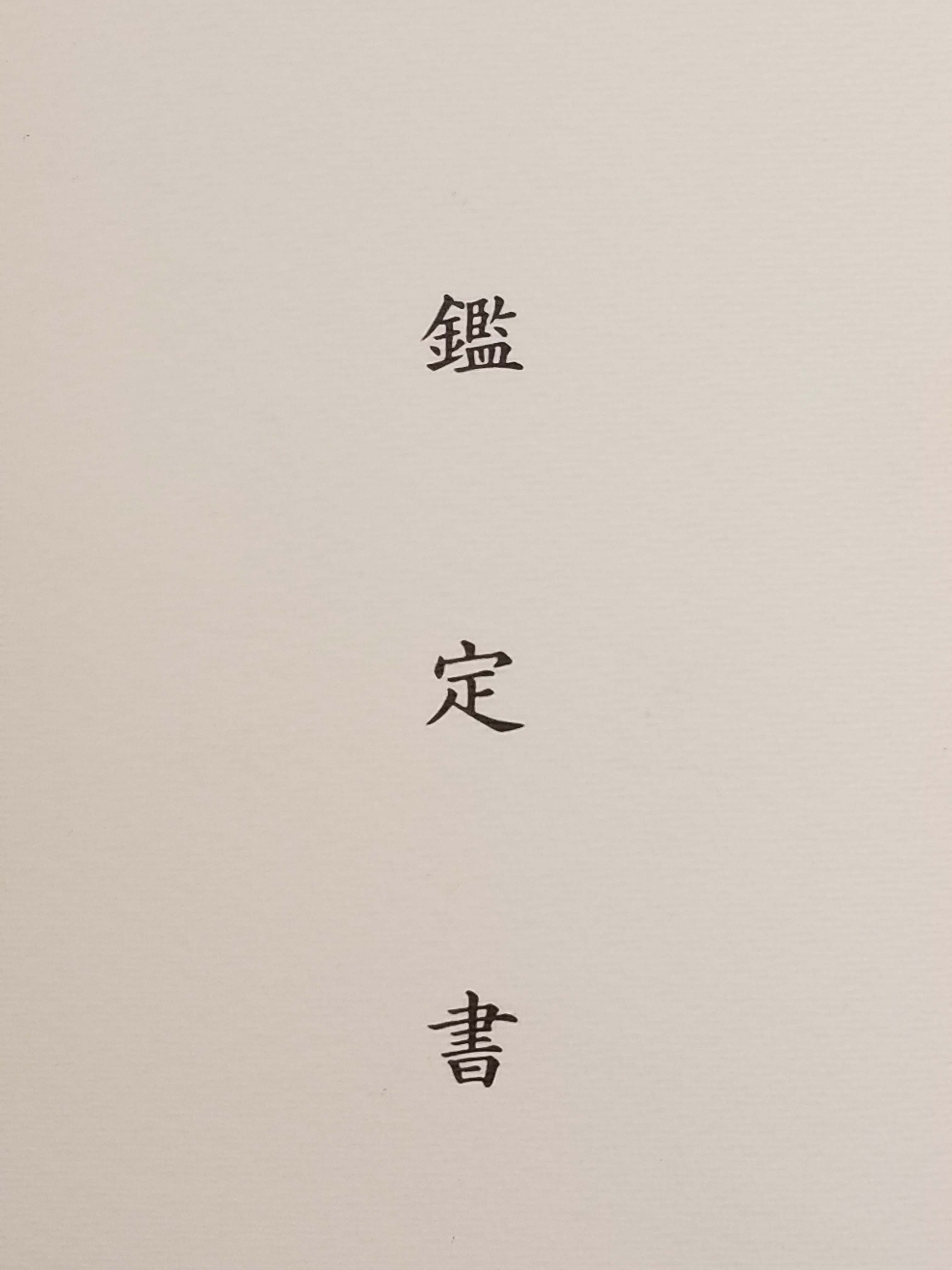
This sword has recently passed shinsa. The official papers will take a few month to be made and sent from Japan. These papers will be forwarded to the new owner when this sword sells.
Test Cutting Information:
During the Edo period, only the most skilled swordsmen were chosen to test swords, so that the swordsman’s skill was not a variable in determining how well the sword cut. The materials used to test swords varied greatly. Some substances were wara (rice straw), goza (the top layer of tatami mats), bamboo, and thin steel sheets.
In addition, there were a wide variety of cuts used on cadavers and occasionally convicted criminals back in the 1600’s, from tabi-gata (ankle cut) to O-kesa (diagonal cut from shoulder to opposite hip). The names of the types of cuts on cadavers show exactly where on the body the cut was made. Older swords can still be found today that have inscriptions on their nakago (tang) that say things such as, “5 bodies with Ryu Guruma (hip cut)”. Such an inscription, known as a tameshi-mei or saidan-mei (cutting signature) would add greatly to a sword’s value, compensating the owner somewhat for the large sums of money typically charged for the test.
Aside from specific cuts made on cadavers, there were the normal cuts of Japanese swordsmanship, i.e. downward diagonal (Kesa-giri), upward diagonal (Kiri-age or Gyaku-kesa), horizontal (Yoko or Tsuihei), and straight downward (Jodan-giri, Happonme, Makko-giri, Shinchoku-giri or Dottan-giri).
There is an apocryphal story of a condemned criminal who, after being told he was to be executed by a sword tester using a Kesa-giri cut, calmly joked that if he had known that was going to happen, he would have swallowed large stones to damage the blade.
A brief history of Yamada asa’emon Yoshitoshi the Tester of this sword.
Yoshimasa was succeeded by his son-in-law Yoshitoshi (吉利). Yoshitoshi, who also wrote his name with the characters (吉年), was born in Bunka ten (1813), the second son of GotōGozaemon (後藤五左衛門) who was a retainer of the Niimi fief (新見藩) of Bitchūprovince, a tameshigiri student, and a meritorious clerk of the Yamada family. Incidentally, Gozaemon´s first son Shintarō(新太郎) also studied sword testing with the Yamada. Yoshitoshi was first called Gosaburō(五三郎) and Toshishige (利重) and used the haigōShibō´en-Wazui (芝生園和水). Please also note that he changed the writing of the hereditary name Asaemon back to (浅右衛門). He married Kō(幸), the daughter of the late Yoshiyasu, who had been adopted by Yoshimasa. A proof of the level of confidence in his future son-in-law is the blade presented on the next page. Yoshimasa allowed his then student Yoshitoshi, still named GotōGosaburō, to perform a cutting test with a blade by Koyama Munetsugu ordered by a retainer of the Furukawa fief (古河藩) of Shimōsa province.
The active period of the seventh Yamada-generation Yoshitoshi fell into the turbulent bakumatsu era. There were more and more foreigners appearing at the coasts and the bakufu and the fiefs, although already heavily stricken financially, were arming themselves. Another factor contributing to Yoshitoshi’s income was that with all the political measures taken by the Shogunate, death sentences became the order of the day which meant a steady supply of tameshigiri mediums. During the Ansei Purge (Ansei no taigoku, 安政の大獄) alone, from the years 1858-1860 almost one hundred death sentences were imposed. Apart from the years after the loss of their residence, it is generally assumed that the Yamada family enjoyed a wealth about equivalent to that of a bushi or daimyōwith an annual income of 10,000 koku.
Yoshitoshi was also a sword connoisseur, famous for his sword appraisals, and this knowledge earned him the post of kōgi-koshimono-haiken yaku (公儀腰物拝見役), meaning “officer who sees/inspects the swords of the bakufu,” which came with a stipend of rice. The Yamada had always judged swords, but not in an official function, so this meant that Yoshitoshi also gave up the rōnin status of the family. This is also special as, since the establishment of the Tokugawa-bakufu, the Hon´ami family had held the post of official sword appraisers alone. There is no other known case where the Shogunate had appointed a second official sword appraiser as in the case with Yoshitoshi. And he inserted in the family genealogy the note “special privilege which none of my ancestors had.”
The end of the Shogunate and the start of the Meiji Restoration also meant several changes of course for the Yamada family. First of all, on the 25th day of the fifth month of Meiji one (明治, 1868), Yoshitoshi was transferred and was now an officer at the Municipal Court House (Shisei-saibansho, 市政裁判所). One year later, at the age of 57, he retired, handed the reins of the family to his son Yoshitoyo (吉豊), and moved to the retirement residence of the Yamada which was located in the Shimizudani neighbourhood (清水谷) six blocks away from the main residence in the Kōjimachi district.
That very same year a famous sword from the estate of the family was presented to Emperor Meiji (明治天皇, 1852-1912) who was also known for his love for swords. The sword in question was the Koryū-Kagemitsu (小竜景光), made by the Bizen smith Kagemitsu in the second year of Genkō(元享, 1322), which was said to have been worn by Kusunoki Masashige (楠木正成, 1294?-1336). A tradition now says that Daigorō(大五郎), the son of the hatamoto Nakamura Kakudayū(中村覚太夫, 1747-1843), found the sword amongst his father’s collection. Kakudayūhad been a renowned sword and tsuba expert and was the bakufu´s Kantō-daikan (関東代官), the deputy of the Kantōregion with administrative and supervising functions, especially in the accountancy of the annual land taxes.*35 So Daigorōtook the sword to an Ōsaka sword dealer to show it to the Hon´ami family. The Hon´ami were beside themselves to see such a healthy and only slightly shortened, fully signed and dated sword by the master smith Kagemitsu, which had in addition been worn by the Nanbokuchō-era hero and samurai model Kusunoki Masashige. Daigorōinformed them that it came from a peasant family from Kawachi province who wanted to have an origami (折紙), a written appraisal, from the Hon´ami. But they were cautious because no family member was able to find any sword from the possessions of Masashige in the hereditary records. So the Hon´ami hesitated and did not issue an origami. Maybe it was because of this, i.e. such a historic piece suddenly popping out of nowhere that the sword did not sell and so it eventually landed in the hands of the Yamada family. The then head, Yoshimasa, sold it to the Ii family (井伊), the daimyōof the Hikone fief (彦根藩), after having it for a while on consignment. Others assume that he first bought it for himself as the family’s finances were healthy at that time, but could not refuse the offer from the Ii. However, when Ii Naosuke (井伊直弼, 1815-1860), the then head of the family, was assassinated in the Sakuradamon Incident in Ansei seven (安政, 1860), the Koryū-Kagemitsu was sold back to Yamada Yoshitoshi. Maybe Yoshitoshi foresaw the upcoming difficulties his family would feel when the Meiji Restoration was launched and thus decided donate it to the emperor because the Imperial Household Agency replied to this gift with the sum of 500 Yen (today about 2,000,000 Yen which converts to about 20,000 USD or 14,000 Euro). Another transmission says that the sword was actually bought by the master swordsman Yamaoka Tesshū(山岡鉄舟, 1836-1888) who presented it to the Imperial Household Agency. And a third transmission says that the Koryū-Kagemitsu was bought directly by Emperor Meiji himself. Well, there are several doubts about this story but fact is that Koyama Munetsugu, the smith pushed by the Yamada family, made at least two copies of the sword, one in the then condition, and one as a reconstruction of how the blade must have looked like unshortened. The former is dated Kōka four (1847) and the latter Bunkyūtwo (文久, 1862). The copy is very close to the original, which means that Munetsugu must have had access to the blade and did not simply make a copy on the basis of oshigata, measurements, and descriptions. And with this in mind, it is likely that at least by the mid-1840s or early 1860s the Koryū-Kagemitsu must have been in the possession of the Yamada family.
Back to Yoshitoshi´s career after the start of the Meiji Restoration. The first major impact for the Yamada family was in the fourth month of Meiji three (1870) when the new government prohibited the sale of medicine made from human organs. This thwarted Yoshitoshi´s plan to focus on the sale and marketing of the Yamada-gan during his retirement. But there was still another field of activity left for him, namely that of judging swords. As mentioned before, he held the post of sword inspector for the bakufu just before the feudal system ended. Back then, he scheduled the judgement and appraisal of swords for the evening hours but now this was going to be a fulltime job. We know from reports that even prominent figures of that time, like the politician and later prime minister Kuroda Kiyotaka (黒田清隆, 1840-1900), the statesman Katsu Kaishū(勝海舟, 1823-1899), and the senator Ōkubo Ichiō(大久保一翁, 1818-1888) approached Yoshitoshi for an opinion on the quality and potential cutting ability of their swords. Yoshitoshi died on the 29th day of the twelfth month of Meiji 17 (1884) at the age of 72. His posthumous Buddhist name is Tenjū´in-Keishin-Wazui (天寿院慶心和水) and his death poem goes:
Kaze no aru uchibakari nari yakko-dako.
(風のある内ばかりなり奴凧)
“The kite in the form of a footman*36 only flies when it´s windy.”
*36 A theory says that such yakko-dako (奴凧) were used by persons of lower rank as a kind of repayment, or for making fun of daimyō or higher ranking persons, because by flying such a kite over their residences it was as if the footman were looking down on them.
As mentioned, Yoshitoshi retired in Meiji two (1869) and was succeeded by his son Yoshitoyo (吉豊). This was the first time in many years that the first born, and not an adopted son, took over the Yamada family. Yoshitoyo was born on the 15th day of the fifth month of Tenpōten (1839). He first bore the first name Genzō(源蔵), later took over the hereditary name Asaemon, but changed it to Asao (浅雄) after the Meiji era had started. Before taking the Yamada name Yoshitoyo, it is assumed that he used the name Yoshitsugu (吉次) as there is a blade by the swordsmith Takahashi Naganobu (高橋長信) known which bears a cutting test performed in Ansei six (1859) which mentions Yamada Yoshitsugu as the tester. The same law passed in the fourth month of Meiji three (1870) prohibiting the sale of medicine made from human organs also prohibited the use of the bodies of executed felons for tameshigiri. In short, the Yamada family lost in a single blow almost all of their income. But Yoshitoyo received the newly established post of Tōkyō-fu shūgoku-kakarikiri yaku (東京府囚獄掛斬役, meaning “Executioner for the Prisons in TōkyōPrefecture”).
In Meiji four (1872), the new government started with the nationwide registration of the population called jinshin-koseki (壬申戸籍), which was finished in Meiji five (1873). In this registration, distinctions were basically*37 made between the imperial family (kōzoku, 皇族), nobility (kazoku, 華族, which contained the former daimyō), warrior families (shizoku, 士族, all former samurai), and commoners (heimin, 平民). Interestingly, this means that although Yoshitoshi received the post of the sword inspector for the bakufu, and the fact that the members of the Yamada family were allowed to carry swords, both Yoshitoyo and Yoshitoshi were registered as heimin and not as shizoku.
Onibushi Yoshikuni was a shinshintô era swordsmith who worked for the Hachinohe-Nanbu fief (八戸南部藩) of northern Mutsu province which was ruled by the Nanbu family of the same name. There is not much information known on him but the meikan date him around Kôka (弘化, 1844-1848). Yoshitoshi was the 7th generation of the famous Yamada Asa’emon family of sword testers. He lived from 1813 to 1884 and took over the Yamada family in 1852.
mei ura:
Yamada Asa’emon Yoshitoshi (山田朝右衛門吉利) Mitsu-dô dotanbarai Ansei roku hitsujidoshi nigatsu nanoka kore o tamesu (試三ッ胴土壇拂安政六未年二月七日之) – “Yamada Asaemon Yoshitoshi Tested on the seventh day of the second month of Ansei six (1859), year of the sheep, by cutting through three bodies and into the earthen mound beneath.”
For Sale





















